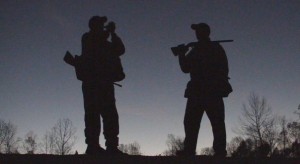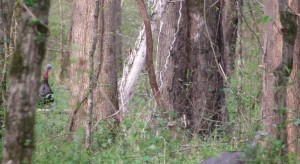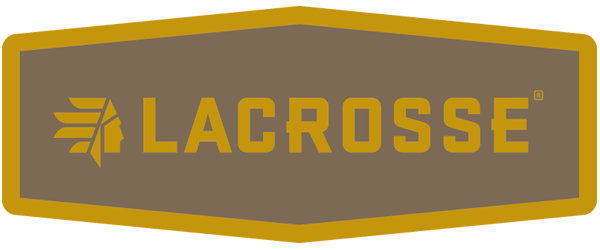Shane Simpson of CallingAllTurkeys.com
When it comes to turkey hunting, most hunters would never even consider heading afield without some sort of a locator call. Most are fairly easy to use and very helpful at pinpointing a gobbler’s position without the threat are luring him in. After all, you’re only trying to locate a bird and after that is accomplished, you can set up and start working him with turkey calls. There are three different types of locator calls that I keep in my vest and each may see some use throughout a typical day in the spring woods. They are the crow, owl and goose calls. In this article, I will explain why I use each those calls and why you should too.

The author and his brother, Kane Simpson, try to shock a gobbler at daybreak.
Scarecrow and the King
Let’s start off with one of the most common locator calls available today, the crow call. The American Crow can be found in almost every part of the United States so it’s safe to say, wherever you find the king of the spring woods, then there are also crows. Crow calls are probably the easiest calls to use. Simply blow air through the call and you are instantly making crow sounds. That’s fine if the gobblers in your area easily gobble at any loud sound but what if they are somewhat hush mouthed? Giving short, loud burst from your crow call might do the trick or it might take a quick follow up series to get that silent Tom to talk. If you have ever spent any time around a pet turkey or farm turkey, then you know when he is about to gobble by just observing his body language. The neighbor’s dog is barking and that big farm bird drops slightly from strut, stretches his neck up and out just a bit and his snood starts to contract. Just one more bark or any other loud noise and he will let out a throaty gobble. If the neighbor’s dog stops barking instead, that farm bird will most likely go back to feeding or strutting for his lady friends. It’s the same with wild turkeys. You hit that crow call hard with no response and so you move on down the trail and try again. Instead, if you would have waited just a second or two after your first call and then tried again, you may have gotten a response. Often times, a gobbler may be strutting to hens or simply feeding through the woods and your first series of crow calls does nothing more than get his attention. A quick, follow up blast might have been all that was needed to cause that Tom to sound off.
Realism in your crow calling can also help you locate a silent Tom. What does realism have to do with getting a Tom to gobble you ask? Well, it has more to do with fooling other crows and less with fooling the gobblers. If you have ever been near a large gathering of crows then you know they can definitely make quite a racket. Making realistic crow sounds can attract other crows and if they join into your conversation, the added calls from multiple directions might be enough to get an old bird to rattle the woods. I’m not just talking about making realistic “caws” either but rather making a full spectrum of realistic crow calls. Distress calls, rally calls, fighting calls, just to name a few. The more calls that you can realistically reproduce, the better your odds at drawing in real crows and the added ruckus might just help to draw out a gobble. Don’t worry about making too much noise either, if it sounds real, it’s unlikely that you’ll spook any nearby turkeys. Turkeys are accustomed to hearing crows and they will either gobble to your attempts or simply go about their business.
Whatcha Cooking?
The Barred Owl is probably one of my favorite calls to locate gobblers with. From the common, 8 note vocalization, “Who cooks for you, who cooks for ya’ll?”, to the humorous sounding “laughs” and seldom heard “scream”, the vocalizations of the Barred Owl simply intrigues and amazes me. The owl call was the first locator call that I ever purchased and I instantly fell in love with it. I have spent an enormous amount of time trying to replicate realistic owl sounds, a task that I continue to this day. After many years of practice, I’ve gotten good enough to use those skills on the competition stage. Reproducing owls sounds is somewhat of an addiction for me and is probably why it is my first choice for a locator call. It’s also why I discovered that an owl call can be a great tool when trying to elicit a gobble during all parts of the day. Most hunters use owl calls at day break and quickly switch over to other locator calls for the remainder of the day. I, on the other hand, like to let the turkeys hear something they don’t typically hear during the day and more often than not, I hit paydirt. Sure, I’ll occasionally use a crow call but if that fails, I’m reaching into my vest for my Harrison Hoot’n Stick. Few hunters take advantage of this call during midday hours and I find that a few hoots is all it takes to get a gobbler to rattle the woods.
Weather you decide to use a owl call strictly in the early morning or during all times of the day, there is certain sequence of owl calls that I recommend be used. On your first attempt to shock a gobbler, a short “whooo” sound should be made. If that fails then quickly go into the 8 note series, “Who cooks for you, who cooks for ya’ll?”. If you have a hunting buddy with you, he or she should stand at least 5-10 yards away from you to help listen for distant gobbles over your owl calling. If you’re alone, try to perform the 8 note call without blending the notes, instead making short notes with even short pauses in between. If a Tom decides to gobble then there is a good chance you’ll hear part of it between your owl notes. If the 8 note fails to return any gobbles then make another 8 note call that transitions into “laughs”. The “laugh” of a barred owl sounds a lot like a pile a rambunctious monkeys and, on a good day, can result in birds sounding off in every direction. The problem is, if you do not listen carefully, the “laughs” may drown out the gobbles. You want to build up your calling until you finally get a response but at the same time, allow yourself a chance to hear the very birds you are after.
Duck, Duck, Goose!
You’re working a spring gobbler and a loud mouthed goose flys overhead, what are the odds that you would soon hear a gobble? Most would say nearly 100% and that there is exactly why a goose call is always in my vest. Weather you’re trying to locate a spring bird or simply trying to get a another response so you can re-position a goose call is up to the task. Use it sparingly though, a gobbler may gobble readily at your first few honks but if you play the call too often, it will become just another sound and therefore not as productive. Remember this, a sound that is new or seldom heard by a Tom will most often produce the best results. The cardinals are singing, crows are numerous and noisy, you can hear the constant hum of interstate traffic in the distance and out of the blue, a Pileated woodpecker sounds off. That woodpecker just triggered a gobbler’s response because it was a new sound in nature’s song.

This gobbler wisely stays out of range.
On one of my hunts, many years ago, I remember working my way up a trail that cut along the spine of a ridge. I was attempting to get closer to a gobbler that had responded to my calls earlier that morning but had since gone silent. He would no longer answer my crow, owl or even my turkey calls so I assumed that he was henned up. As I turned to head back to camp, a honking goose flew over. The bird that I’d just given up on sounded off in the creek bottom below. I made my way down a side trail and when I neared the creek, I made a crude goose call with my natural voice. The gobbler answered again and I quickly set up at the base of a nearby tree. After a brief period to allow things to settle down, I let out a few contented yelps and scratched the leaves to imitate a feeding hen. The gobbler instantly hammered back and I began to imagine myself toting him out of the woods. A few minutes later, I yelped some more and again he answered. The gobbler was closer this time but seemed to be moving to my right. I sat there watching and listening and after what seemed like an enormous amount of time (probably just a few minutes), I spotted him with a few female friends. The hens fed up the hillside and out of sight with the gobbler in tow. That ol’ Tom never did respond to any more of my calls and never rode home over my shoulder but I did learn something that day, I do a very poor job at imitating goose calls with my natural voice. Don’t worry, I now carry a manufactured goose call in my turkey vest.
Like I said before, there are numerous locator calls on the market and I’ve tried most of them, but owl and goose calls are the ones that have worked best for me over the years. The animals that they imitate, for the most part, are non-threatening to adult wild turkeys and I can use each call with the confidence that I won’t spook my quarry.
















